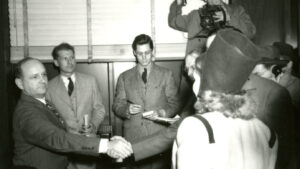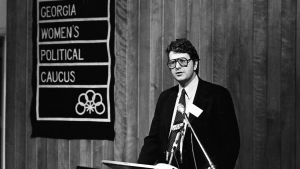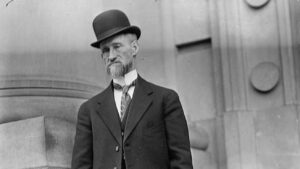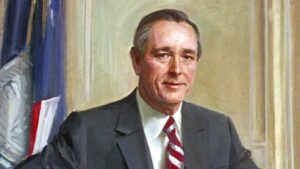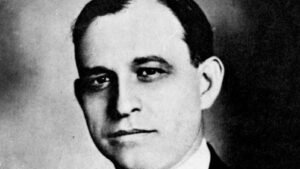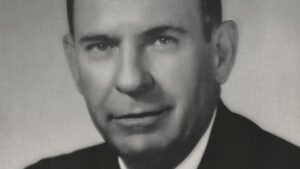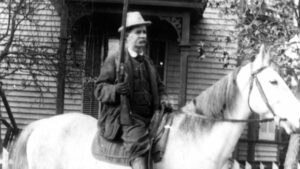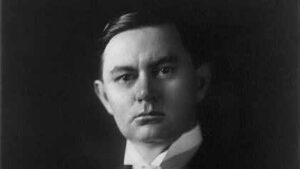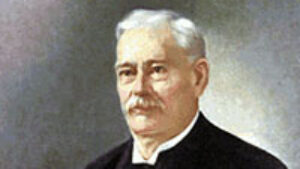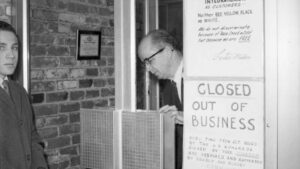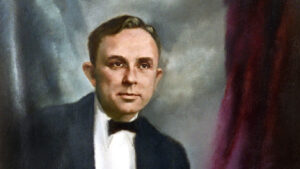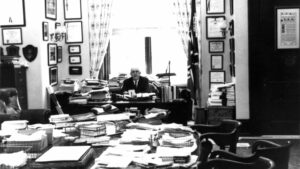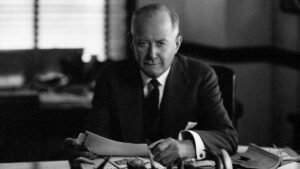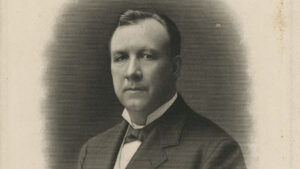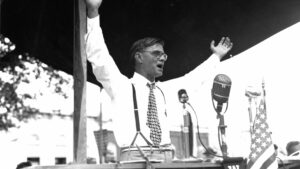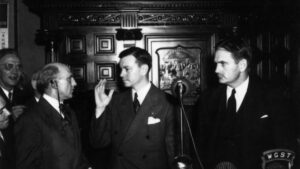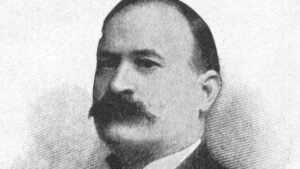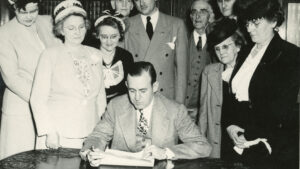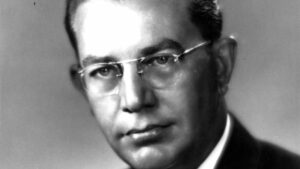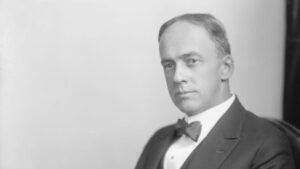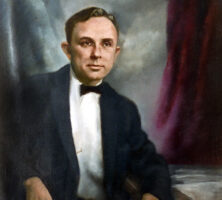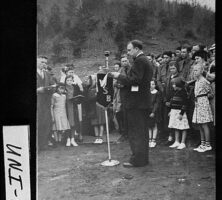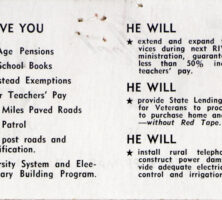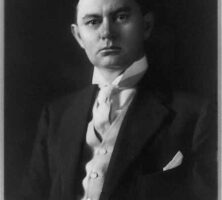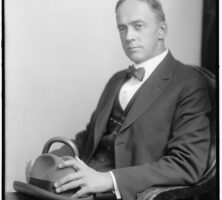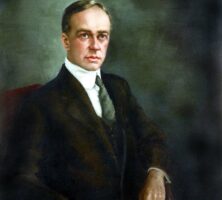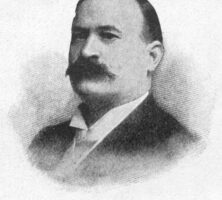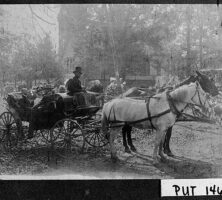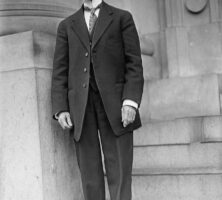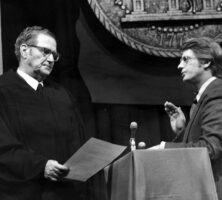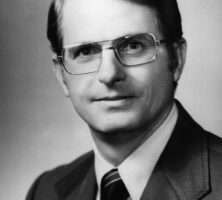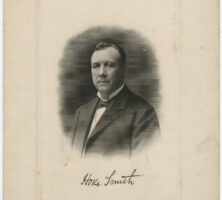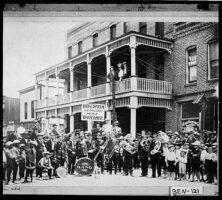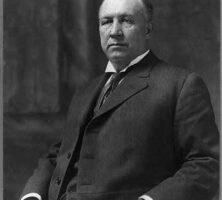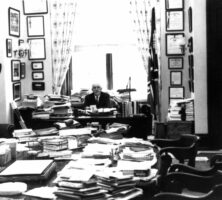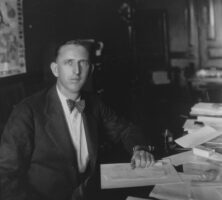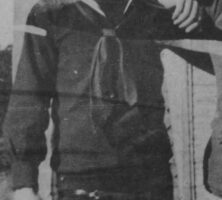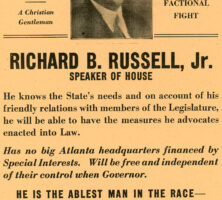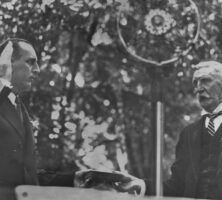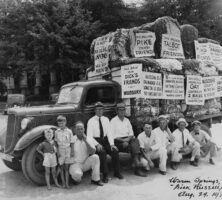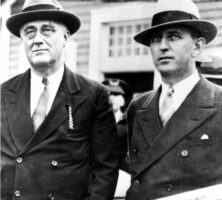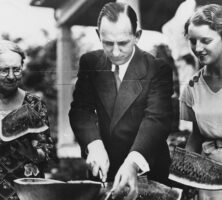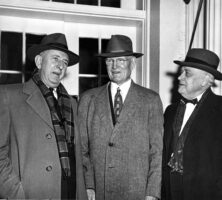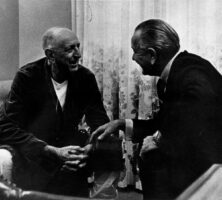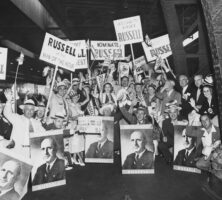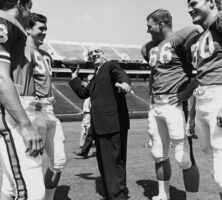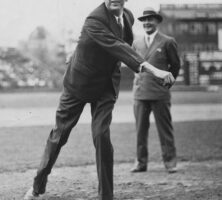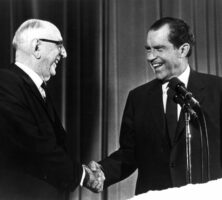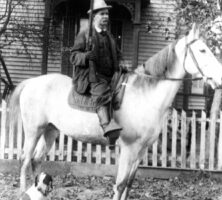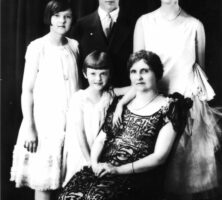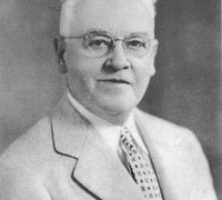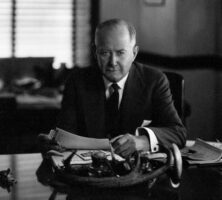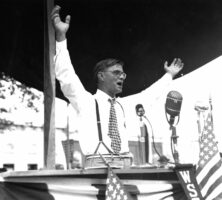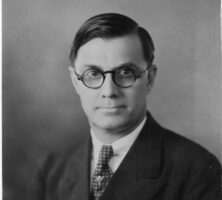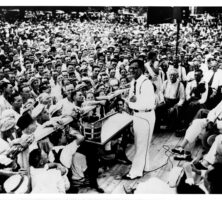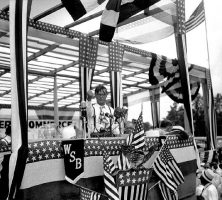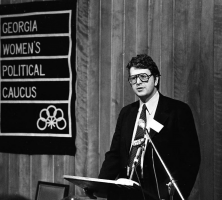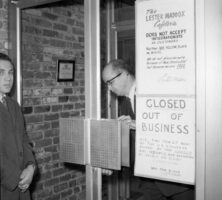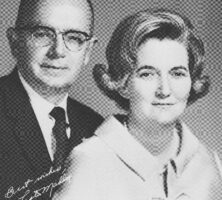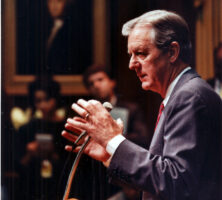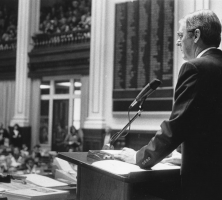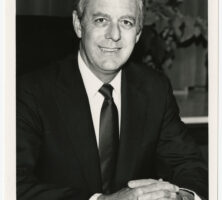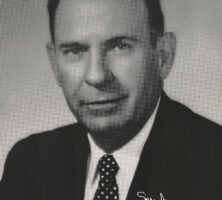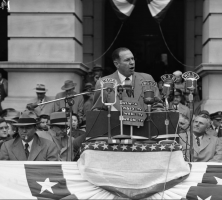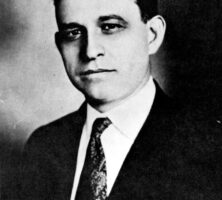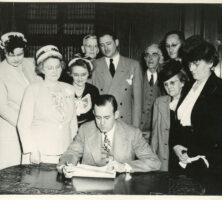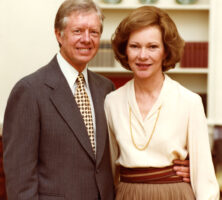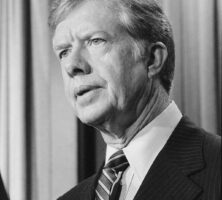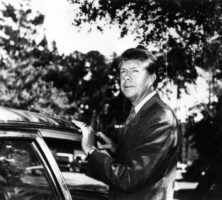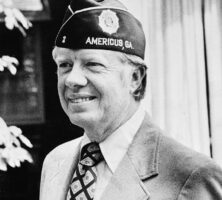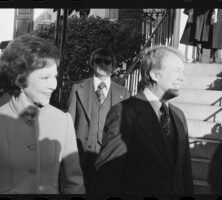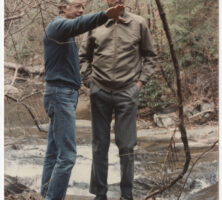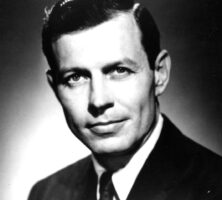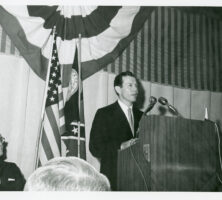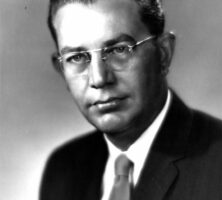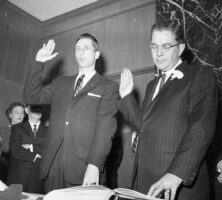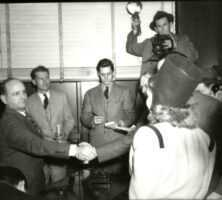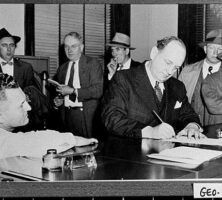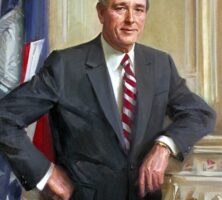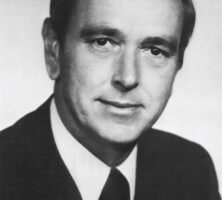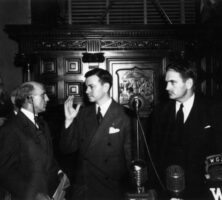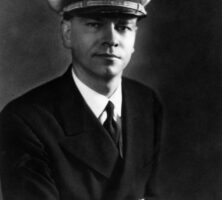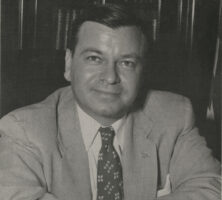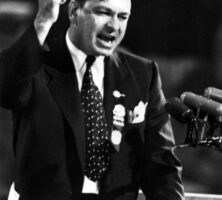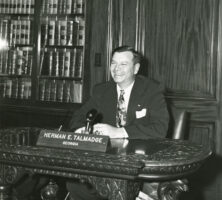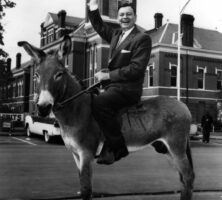The New Georgia Encyclopedia is supported by funding from A More Perfect Union, a special initiative of the National Endowment for the Humanities.
E. D. Rivers, credited with bringing a "Little New Deal" to the state, served two terms as Georgia's governor, from 1937 until 1941. During his first term, Rivers instituted numerous reforms in education, the penal system, and public health. His second term was plagued by accusations of corruption and an inability to finance the measures enacted during his first term.
Courtesy of Georgia Capitol Museum, University of Georgia Libraries
The New Georgia Encyclopedia does not hold the copyright for this media resource and can neither grant nor deny permission to republish or reproduce the image online or in print. All requests for permission to publish or reproduce the resource must be submitted to the rights holder.
E. D. Rivers speaks in 1939, during his second gubernatorial term, at a gathering in Union County, located in the north Georgia mountains. During his first term, Rivers secured federal funding to support public housing and rural electrification in the state.
Courtesy of Georgia Archives, Vanishing Georgia, #uni005.
The New Georgia Encyclopedia does not hold the copyright for this media resource and can neither grant nor deny permission to republish or reproduce the image online or in print. Requests for permission to publish or reproduce the resource should be submitted to the Georgia Archives.
The front side of a promotional card outlining E. D. Rivers's 1938 gubernatorial platform. Rivers was reelected in 1938, but by the end of his second term, his administration was awash in charges of corruption.
Courtesy of Richard B. Russell Library for Political Research and Studies, University of Georgia Libraries, Georgia Ephemera Collection.
The New Georgia Encyclopedia does not hold the copyright for this media resource and can neither grant nor deny permission to republish or reproduce the image online or in print. Requests for permission to publish or reproduce the resource may need to be submitted to the Richard B. Russell Library for Political Research and Studies at the University of Georgia.
The back side of a promotional card outlining E. D. Rivers's 1938 gubernatorial platform.
Courtesy of Richard B. Russell Library for Political Research and Studies, University of Georgia Libraries, Georgia Ephemera Collection.
The New Georgia Encyclopedia does not hold the copyright for this media resource and can neither grant nor deny permission to republish or reproduce the image online or in print. Requests for permission to publish or reproduce the resource may need to be submitted to the Richard B. Russell Library for Political Research and Studies at the University of Georgia.
Thomas Hardwick, pictured circa 1912, became governor of Georgia in 1921. A native of Thomasville, Hardwick also served in the state legislature and in both houses of the U.S. Congress during his political career.
Courtesy of Library of Congress, Prints and Photographs Division
The New Georgia Encyclopedia does not hold the copyright for this media resource and can neither grant nor deny permission to republish or reproduce the image online or in print. All requests for permission to publish or reproduce the resource must be submitted to the rights holder.
The New Georgia Encyclopedia does not hold the copyright for this media resource and can neither grant nor deny permission to republish or reproduce the image online or in print. All requests for permission to publish or reproduce the resource must be submitted to the rights holder.
Clifford Walker, a native of Monroe, was elected as the state's sixty-first governor in 1923. He served two consecutive terms, during which time his ties to the Ku Klux Klan were uncovered by journalist Julian Harris, son of writer Joel Chandler Harris.
Courtesy of Library of Congress, Prints and Photographs Division, Harris & Ewing Collection.
The New Georgia Encyclopedia does not hold the copyright for this media resource and can neither grant nor deny permission to republish or reproduce the image online or in print. All requests for permission to publish or reproduce the resource must be submitted to the rights holder.
Clifford Walker, the governor of Georgia from 1923 to 1927, was born in Monroe and lived there for much of his life. Walker also began his political career in Monroe, where he was elected mayor in 1902.
Courtesy of Georgia Archives, Vanishing Georgia, #
wlt004.
The New Georgia Encyclopedia does not hold the copyright for this media resource and can neither grant nor deny permission to republish or reproduce the image online or in print. Requests for permission to publish or reproduce the resource should be submitted to the Georgia Archives.
Clifford Walker, the sixty-first governor of Georgia, achieved little legislatively during his tenure and is best remembered for his ties to the Ku Klux Klan.
Courtesy of Georgia Capitol Museum, University of Georgia Libraries, Capitol Art Collection (Capitol Museum Collection), #1992.23.0058.
The New Georgia Encyclopedia does not hold the copyright for this media resource and can neither grant nor deny permission to republish or reproduce the image online or in print. All requests for permission to publish or reproduce the resource must be submitted to the rights holder.
Joseph M. Terrell, a native of Meriwether County, was known as Georgia's "education governor." He served two consecutive terms, from 1902 to 1907, during which time he passed legislation creating eleven district agricultural and mechanical schools. Terrell also served as the state attorney general and as a U.S. senator during his political career.
The New Georgia Encyclopedia does not hold the copyright for this media resource and can neither grant nor deny permission to republish or reproduce the image online or in print. All requests for permission to publish or reproduce the resource must be submitted to the rights holder.
Nathaniel E. Harris served as the governor of Georgia from 1915 to 1917. His primary focus was on the improvement of public services and social welfare. A strong advocate for public education, Harris also instituted compulsory education and reformed teacher pay during his tenure.
Courtesy of Georgia Captiol Museum, Office of Secretary of State
The New Georgia Encyclopedia does not hold the copyright for this media resource and can neither grant nor deny permission to republish or reproduce the image online or in print. All requests for permission to publish or reproduce the resource must be submitted to the rights holder.
Joseph M. Brown (hatless man in back of carriage) and others return to Atlanta from a racetrack in Eatonton, circa 1907. Brown served on the Georgia State Railroad Commission from 1904 until 1907 and was elected to his first term as governor in 1909.
Courtesy of Georgia Archives, Vanishing Georgia, #
put146.
The New Georgia Encyclopedia does not hold the copyright for this media resource and can neither grant nor deny permission to republish or reproduce the image online or in print. Requests for permission to publish or reproduce the resource should be submitted to the Georgia Archives.
Railroad commissioner and author Joseph M. Brown served two terms as governor, in 1909-11 and in 1912-13. He was the son of Georgia's Civil War governor, Joseph E. Brown.
Courtesy of Library of Congress, Prints and Photographs Division
The New Georgia Encyclopedia does not hold the copyright for this media resource and can neither grant nor deny permission to republish or reproduce the image online or in print. All requests for permission to publish or reproduce the resource must be submitted to the rights holder.
The frontispiece to Joseph M. Brown's Astyanax (1907), illustrated by William Lincoln Hudson, depicts the novel's warrior hero, Astyanax, telling a little girl that "sunbeams are hard to catch." Brown, a governor of Georgia, also wrote The Mountain Campaigns in Georgia (1886), a Civil War military history.
From Astyanax, by J. M. Brown
The New Georgia Encyclopedia does not hold the copyright for this media resource and can neither grant nor deny permission to republish or reproduce the image online or in print. All requests for permission to publish or reproduce the resource must be submitted to the rights holder.
During his sixteen years as lieutenant governor, Zell Miller sparred regularly with Tom Murphy, the longitime Speaker of the state house.
Courtesy of Atlanta History Center.
The New Georgia Encyclopedia does not hold the copyright for this media resource and can neither grant nor deny permission to republish or reproduce the image online or in print. Requests for permission to publish or reproduce the resource should be submitted to the Atlanta History Center.
The New Georgia Encyclopedia does not hold the copyright for this media resource and can neither grant nor deny permission to republish or reproduce the image online or in print. All requests for permission to publish or reproduce the resource must be submitted to the rights holder.
Zell Miller is officially sworn in as Georgia's eighth Lieutenant Governor in 1975. He served for four consecutive four-year terms.
The New Georgia Encyclopedia does not hold the copyright for this media resource and can neither grant nor deny permission to republish or reproduce the image online or in print. Requests for permission to publish or reproduce the resource should be submitted to Special Collections and Archives at Georgia State University.
Zell Miller, pictured here during his tenure as lieutentant governor, was elected to that office in 1975 and held it for sixteen years. Miller began his political career in 1959, when he became mayor of Young Harris, his hometown. By the 1970s, Miller had served as a state senator for two terms and as the executive secretary to Governor Lester Maddox.
Image from Georgia Secretary of State
The New Georgia Encyclopedia does not hold the copyright for this media resource and can neither grant nor deny permission to republish or reproduce the image online or in print. All requests for permission to publish or reproduce the resource must be submitted to the rights holder.
The New Georgia Encyclopedia does not hold the copyright for this media resource and can neither grant nor deny permission to republish or reproduce the image online or in print. All requests for permission to publish or reproduce the resource must be submitted to the rights holder.
Governor Hoke Smith is perhaps the figure most associated with Progressive era reform in the state. During his governorship reforms were seen in education and railroad regulation; the convict lease system was abolished; and a major public health project, a state sanatorium for tuberculosis patients, was undertaken.
The New Georgia Encyclopedia does not hold the copyright for this media resource and can neither grant nor deny permission to republish or reproduce the image online or in print. Requests for permission to publish or reproduce the resource should be submitted to the Hargrett Manuscript and Rare Book Library at the University of Georgia.
Residents of Fitzgerald in Ben Hill County gather for a political rally for Hoke Smith, owner of the Atlanta Journal, during the gubernatorial race of 1906. Smith, the Democratic candidate, won the election over Clark Howell, his rival publisher at the Atlanta Constitution.
Courtesy of Georgia Archives, Vanishing Georgia, #
ben121.
The New Georgia Encyclopedia does not hold the copyright for this media resource and can neither grant nor deny permission to republish or reproduce the image online or in print. Requests for permission to publish or reproduce the resource should be submitted to the Georgia Archives.
Hoke Smith poses for a portrait in 1912, the year after his second term as Georgia's governor had ended. Smith served as governor first from 1907 to 1909 and then again in 1911, until he was selected to fill the empty U.S. Senate seat of Joseph M. Terrell. He remained in this seat until 1921.
Courtesy of Library of Congress, Prints and Photographs Division
The New Georgia Encyclopedia does not hold the copyright for this media resource and can neither grant nor deny permission to republish or reproduce the image online or in print. All requests for permission to publish or reproduce the resource must be submitted to the rights holder.
A U.S. senator from Georgia for thirty-eight years, Richard B. Russell Jr. became one of the most influential senators of his time. From 1935 until the passage of the Civil Rights Act in 1964, Russell used his clout as leader of the Southern Bloc in the Senate to prevent the passage of national civil rights legislation.
Courtesy of Richard B. Russell Library for Political Research and Studies, University of Georgia Libraries, Richard B. Russell Jr. Collection.
The New Georgia Encyclopedia does not hold the copyright for this media resource and can neither grant nor deny permission to republish or reproduce the image online or in print. Requests for permission to publish or reproduce the resource may need to be submitted to the Richard B. Russell Library for Political Research and Studies at the University of Georgia.
Richard B. Russell Jr. became one of the youngest members of the Georgia House of Representatives upon his election in 1920. By the time of this 1928 photograph, he was serving as Speaker of the House. Russell would later take office in 1931 as Georgia's youngest governor, and he entered national politics as a U.S. senator in 1933.
Courtesy of Richard B. Russell Library for Political Research and Studies, University of Georgia Libraries, Richard B. Russell Jr. Collection.
The New Georgia Encyclopedia does not hold the copyright for this media resource and can neither grant nor deny permission to republish or reproduce the image online or in print. Requests for permission to publish or reproduce the resource may need to be submitted to the Richard B. Russell Library for Political Research and Studies at the University of Georgia.
In 1918, following his graduation from the University of Georgia law school, Richard B. Russell Jr. enlisted in the U.S. Naval Reserve Forces. Russell began practicing law the following year, and in 1920 began his political career as a state representative.
Courtesy of Richard B. Russell Library for Political Research and Studies, University of Georgia Libraries, Richard B. Russell Jr. Collection.
The New Georgia Encyclopedia does not hold the copyright for this media resource and can neither grant nor deny permission to republish or reproduce the image online or in print. Requests for permission to publish or reproduce the resource may need to be submitted to the Richard B. Russell Library for Political Research and Studies at the University of Georgia.
Richard B. Russell Jr. announced his candidacy for governor in April 1930 and took the oath of office in June 1931. Russell ran a strong grassroots campaign to win the election over several more experienced candidates.
Courtesy of Richard B. Russell Library for Political Research and Studies, University of Georgia Libraries, Richard B. Russell Jr. Collection.
The New Georgia Encyclopedia does not hold the copyright for this media resource and can neither grant nor deny permission to republish or reproduce the image online or in print. Requests for permission to publish or reproduce the resource may need to be submitted to the Richard B. Russell Library for Political Research and Studies at the University of Georgia.
Richard B. Russell Jr. was sworn in as the youngest governor of Georgia by his father, Richard B. Russell Sr., in June 1931. During his eighteen-month tenure, Russell reduced the size of state government, balanced the state budget, and organized the University System of Georgia.
Courtesy of Richard B. Russell Library for Political Research and Studies, University of Georgia Libraries, Richard B. Russell Jr. Collection.
The New Georgia Encyclopedia does not hold the copyright for this media resource and can neither grant nor deny permission to republish or reproduce the image online or in print. Requests for permission to publish or reproduce the resource may need to be submitted to the Richard B. Russell Library for Political Research and Studies at the University of Georgia.
Volunteers gather beside a campaign wagon used during Richard B. Russell Jr.'s 1936 campaign against Georgia governor Eugene Talmadge for a seat in the U.S. Senate. This campaign was one of only two contested elections for Russell during his tenure as a U.S. senator, from 1933 until his death in 1971.
Courtesy of Richard B. Russell Library for Political Research and Studies, University of Georgia Libraries, Richard B. Russell Jr. Collection.
The New Georgia Encyclopedia does not hold the copyright for this media resource and can neither grant nor deny permission to republish or reproduce the image online or in print. Requests for permission to publish or reproduce the resource may need to be submitted to the Richard B. Russell Library for Political Research and Studies at the University of Georgia.
Richard B. Russell Jr. (right) campaigns in Warm Springs for U.S. presidential candidate Franklin D. Roosevelt in 1932. Russell, upon his election to the U.S. Senate in 1933, helped to ensure passage of Roosevelt's New Deal programs throughout the 1930s.
The New Georgia Encyclopedia does not hold the copyright for this media resource and can neither grant nor deny permission to republish or reproduce the image online or in print. Requests for permission to publish or reproduce the resource may need to be submitted to the Richard B. Russell Library for Political Research and Studies at the University of Georgia.
Richard B. Russell Jr. participates in a 1933 festival with his mother (left) and sister (right). During this year Russell was elected to the U.S. Senate and appointed to the Naval Affairs Committee, the first of many powerful committee appointments during his long tenure as senator.
The New Georgia Encyclopedia does not hold the copyright for this media resource and can neither grant nor deny permission to republish or reproduce the image online or in print. Requests for permission to publish or reproduce the resource may need to be submitted to the Richard B. Russell Library for Political Research and Studies at the University of Georgia.
Richard B. Russell Jr. (left), who served from 1933 to 1971 as a U.S. senator from Georgia, stands with fellow senators Carl Hayden of Arizona (center) and Alexander Wiley of Wisconsin (right) in 1955.
Photograph by Abbie Rowe, National Park Service. Courtesy of Dwight D. Eisenhower Presidential Library, National Archives and Records Administration
The New Georgia Encyclopedia does not hold the copyright for this media resource and can neither grant nor deny permission to republish or reproduce the image online or in print. All requests for permission to publish or reproduce the resource must be submitted to the rights holder.
U.S. senator Richard B. Russell Jr. (left) converses with U.S. president Lyndon B. Johnson in 1968. Russell, an early supporter of and mentor to Johnson, criticized the Johnson administration's escalation of the war in Vietnam during the 1960s.
Courtesy of Richard B. Russell Library for Political Research and Studies, University of Georgia Libraries, Richard B. Russell Jr. Collection.
The New Georgia Encyclopedia does not hold the copyright for this media resource and can neither grant nor deny permission to republish or reproduce the image online or in print. Requests for permission to publish or reproduce the resource may need to be submitted to the Richard B. Russell Library for Political Research and Studies at the University of Georgia.
Supporters campaign at the 1952 Democratic National Convention for the presidential nomination of Richard B. Russell Jr., a U.S. senator from Georgia. Russell won the Florida primary after announcing his candidacy but lost the party's nomination to Adlai Stevenson during the convention.
Courtesy of Richard B. Russell Library for Political Research and Studies, University of Georgia Libraries, Richard B. Russell Jr. Collection.
The New Georgia Encyclopedia does not hold the copyright for this media resource and can neither grant nor deny permission to republish or reproduce the image online or in print. Requests for permission to publish or reproduce the resource may need to be submitted to the Richard B. Russell Library for Political Research and Studies at the University of Georgia.
A graduate of the law school at the University of Georgia, U.S. senator Richard B. Russell Jr. visits the school's football team at Sanford Stadium in 1969.
Courtesy of Richard B. Russell Library for Political Research and Studies, University of Georgia Libraries, Richard B. Russell Jr. Collection.
The New Georgia Encyclopedia does not hold the copyright for this media resource and can neither grant nor deny permission to republish or reproduce the image online or in print. Requests for permission to publish or reproduce the resource may need to be submitted to the Richard B. Russell Library for Political Research and Studies at the University of Georgia.
Richard B. Russell Jr. of Georgia, for whom this building was renamed in 1972, became a prominent and respected senator during his thirty-eight-year tenure in the U.S. Senate. Completed in 1908, this oldest of the Senate office buildings is designed in the Beaux-Arts style and is constructed with marble, limestone, and granite.
Photograph by Larry Lamsa
The New Georgia Encyclopedia does not hold the copyright for this media resource and can neither grant nor deny permission to republish or reproduce the image online or in print. All requests for permission to publish or reproduce the resource must be submitted to the rights holder.
Richard B. Russell Jr. throws the first pitch at an Atlanta Crackers game in 1931, the same year in which he took the oath of office as Georgia's youngest governor.
Courtesy of Richard B. Russell Library for Political Research and Studies, University of Georgia Libraries, Richard B. Russell Jr. Collection.
The New Georgia Encyclopedia does not hold the copyright for this media resource and can neither grant nor deny permission to republish or reproduce the image online or in print. Requests for permission to publish or reproduce the resource may need to be submitted to the Richard B. Russell Library for Political Research and Studies at the University of Georgia.
Richard B. Russell Jr., a U.S. senator from Georgia, greets U.S. president Richard Nixon.
Courtesy of Richard B. Russell Library for Political Research and Studies, University of Georgia Libraries, Richard B. Russell Jr. Collection.
The New Georgia Encyclopedia does not hold the copyright for this media resource and can neither grant nor deny permission to republish or reproduce the image online or in print. Requests for permission to publish or reproduce the resource may need to be submitted to the Richard B. Russell Library for Political Research and Studies at the University of Georgia.
Produced by the University of Georgia College of Education and General Mills, The School That Learned to Eat (1948) is a short film chronicling a community's efforts to improve the school lunch program at East Griffin Elementary School in Spalding County.
The New Georgia Encyclopedia does not hold the copyright for this media resource and can neither grant nor deny permission to republish or reproduce the image online or in print. Requests for permission to publish or reproduce the resource may need to be submitted to the Richard B. Russell Library for Political Research and Studies at the University of Georgia.
Issued in 1984, this 10 cent postage stamp honors Richard B. Russell, the youngest governor in Georgia's history.
Courtesy of Smithsonian National Postal Museum
The New Georgia Encyclopedia does not hold the copyright for this media resource and can neither grant nor deny permission to republish or reproduce the image online or in print. All requests for permission to publish or reproduce the resource must be submitted to the rights holder.
Georgia Governor from 1927 to 1931, Lamertine Hardman pictured on a horse holding a rifle. Hardman was one of the wealthiest men in Georgia at the turn of the twentieth century and strove to make governmental processes more efficient
The New Georgia Encyclopedia does not hold the copyright for this media resource and can neither grant nor deny permission to republish or reproduce the image online or in print. Requests for permission to publish or reproduce the resource may need to be submitted to the Richard B. Russell Library for Political Research and Studies at the University of Georgia.
Emma Wiley Griffin, a Valdosta native, married Georgia state representative and future governor Lamartine Hardman in 1907. The couple had four children, three daughters and one son, who are pictured here with their mother in this undated photograph.
Courtesy of Richard B. Russell Library for Political Research and Studies, University of Georgia Libraries, Lamartine G. Hardman Collection.
The New Georgia Encyclopedia does not hold the copyright for this media resource and can neither grant nor deny permission to republish or reproduce the image online or in print. Requests for permission to publish or reproduce the resource may need to be submitted to the Richard B. Russell Library for Political Research and Studies at the University of Georgia.
Atlanta businessman and booster Ivan Allen Sr. cofounded the office supply firm later known as the Ivan Allen Company. He also served a brief stint in 1917 as president of the Atlanta Chamber of Commerce and headed a commission on goverment efficiency for Governor Lamartine Hardman during the early 1930s.
The New Georgia Encyclopedia does not hold the copyright for this media resource and can neither grant nor deny permission to republish or reproduce the image online or in print. All requests for permission to publish or reproduce the resource must be submitted to the rights holder.
Georgia Govenor Lamartine Hardman with President Calvin Coolidge.
The New Georgia Encyclopedia does not hold the copyright for this media resource and can neither grant nor deny permission to republish or reproduce the image online or in print. Requests for permission to publish or reproduce the resource may need to be submitted to the Richard B. Russell Library for Political Research and Studies at the University of Georgia.
Larmartine Hardman (second from right) pictured with the daughter of Crawford Long (to the left of the stone marker) at a tribute to Long in 1922. Long was a Georgian physician who is credited with the discovery of anethesia in 1879.
The New Georgia Encyclopedia does not hold the copyright for this media resource and can neither grant nor deny permission to republish or reproduce the image online or in print. Requests for permission to publish or reproduce the resource may need to be submitted to the Richard B. Russell Library for Political Research and Studies at the University of Georgia.
John Slaton served two terms as governor of Georgia. He is perhaps best known today for his decision to commute the death sentence of Leo Frank in 1915.
The New Georgia Encyclopedia does not hold the copyright for this media resource and can neither grant nor deny permission to republish or reproduce the image online or in print. Requests for permission to publish or reproduce the resource should be submitted to the Hargrett Manuscript and Rare Book Library at the University of Georgia.
In Governor Eugene Talmadge, Franklin D. Roosevelt's New Deal found one of its most vigorous opponents. In Talmadge's first two terms as governor (1933-37), Georgia state government subverted many of the early New Deal programs.
Courtesy of Atlanta History Center.
The New Georgia Encyclopedia does not hold the copyright for this media resource and can neither grant nor deny permission to republish or reproduce the image online or in print. Requests for permission to publish or reproduce the resource should be submitted to the Atlanta History Center.
Eugene Talmadge served as governor of Georgia from 1933 to 1937 and again from 1941 to 1943. His personality and actions polarized voters into Talmadge and anti-Talmadge factions in the state's one-party politics of that era. His death in 1946 touched off the unprecedented "three governors controversy."
Courtesy of Hargrett Rare Book and Manuscript Library, University of Georgia Libraries, Georgia Photo File.
The New Georgia Encyclopedia does not hold the copyright for this media resource and can neither grant nor deny permission to republish or reproduce the image online or in print. Requests for permission to publish or reproduce the resource should be submitted to the Hargrett Manuscript and Rare Book Library at the University of Georgia.
Talmadge's impassioned rhetoric and animated delivery on the campaign trail endeared him to rural and small-town Georgia voters and accounted for much of his political success.
Courtesy of Hargrett Rare Book and Manuscript Library, University of Georgia Libraries, Telamon Cuyler Collection.
The New Georgia Encyclopedia does not hold the copyright for this media resource and can neither grant nor deny permission to republish or reproduce the image online or in print. Requests for permission to publish or reproduce the resource should be submitted to the Hargrett Manuscript and Rare Book Library at the University of Georgia.
Talmadge ran for governor for a fourth term in 1946, promising to restore the white primary and to keep Blacks in their place in Jim Crow Georgia. Talmadge, who had very strong support in rural areas, won the gubernatorial nomination by obtaining a majority of the county unit votes.
The New Georgia Encyclopedia does not hold the copyright for this media resource and can neither grant nor deny permission to republish or reproduce the image online or in print. Requests for permission to publish or reproduce the resource should be submitted to Special Collections and Archives at Georgia State University.
The New Georgia Encyclopedia does not hold the copyright for this media resource and can neither grant nor deny permission to republish or reproduce the image online or in print. All requests for permission to publish or reproduce the resource must be submitted to the rights holder.
Roy Barnes served eight terms as a Georgia state senator (1974-1990). After his second term he was named chair of the Senate Judiciary Committee and also served as floor leader for Governor Joe Frank Harris.
Courtesy of Special Collections & Archives, Georgia State University Library, Atlanta Journal-Constitution Photographic Archive.
The New Georgia Encyclopedia does not hold the copyright for this media resource and can neither grant nor deny permission to republish or reproduce the image online or in print. Requests for permission to publish or reproduce the resource should be submitted to Special Collections and Archives at Georgia State University.
The New Georgia Encyclopedia does not hold the copyright for this media resource and can neither grant nor deny permission to republish or reproduce the image online or in print. All requests for permission to publish or reproduce the resource must be submitted to the rights holder.
The New Georgia Encyclopedia does not hold the copyright for this media resource and can neither grant nor deny permission to republish or reproduce the image online or in print. All requests for permission to publish or reproduce the resource must be submitted to the rights holder.
Lestor Maddox locks the doors to the Pickrick restaurant rather than integrating it in 1965. Toward the end of his life, Governor Lester Maddox expressed few regrets and made no apologies for his segregationist beliefs or any of the other political stances he had taken over his career.
Courtesy of Special Collections & Archives, Georgia State University Library, Atlanta Journal-Constitution Photographic Archive.
The New Georgia Encyclopedia does not hold the copyright for this media resource and can neither grant nor deny permission to republish or reproduce the image online or in print. Requests for permission to publish or reproduce the resource should be submitted to Special Collections and Archives at Georgia State University.
Governor Lester Maddox performs his signature trick: riding a bicycle backward.
Courtesy of Atlanta Journal-Constitution.
The New Georgia Encyclopedia does not hold the copyright for this media resource and can neither grant nor deny permission to republish or reproduce the image online or in print. All requests for permission to publish or reproduce the resource must be submitted to the Atlanta Journal-Constitution.
Lester Maddox is photographed shaking hands inside his souvenir store in Underground Atlanta.
Courtesy of Atlanta Journal-Constitution.
The New Georgia Encyclopedia does not hold the copyright for this media resource and can neither grant nor deny permission to republish or reproduce the image online or in print. All requests for permission to publish or reproduce the resource must be submitted to the Atlanta Journal-Constitution.
Lester Maddox and his wife, Virginia Cox, were married in 1936. Their union lasted sixty-one years, until Virginia's death. The picture is autographed by Maddox.
Courtesy of Hargrett Rare Book and Manuscript Library, University of Georgia Libraries, Georgia Photo File.
The New Georgia Encyclopedia does not hold the copyright for this media resource and can neither grant nor deny permission to republish or reproduce the image online or in print. Requests for permission to publish or reproduce the resource should be submitted to the Hargrett Manuscript and Rare Book Library at the University of Georgia.
Since retiring as governor of Georgia in 1991, Harris has published a book and served as vice chair and chair of the University System of Georgia Board of Regents, which oversees the state's public colleges and universities.
Courtesy of Atlanta Journal-Constitution.
The New Georgia Encyclopedia does not hold the copyright for this media resource and can neither grant nor deny permission to republish or reproduce the image online or in print. All requests for permission to publish or reproduce the resource must be submitted to the Atlanta Journal-Constitution.
Joe Frank Harris, Democrat, served as governor of Georgia from 1983 to 1991. By the end of his term Harris had helped secure education reform, the Georgia Dome, the 1996 Olympics, and a more diversified state economy.
The New Georgia Encyclopedia does not hold the copyright for this media resource and can neither grant nor deny permission to republish or reproduce the image online or in print. Requests for permission to publish or reproduce the resource should be submitted to the Hargrett Manuscript and Rare Book Library at the University of Georgia.
Governor Joe Frank Harris addressing the Georgia senate in 1985. Harris served as governor of Georgia from 1983 to 1991.
Courtesy of Special Collections & Archives, Georgia State University Library, Atlanta Journal-Constitution Photographic Archive.
The New Georgia Encyclopedia does not hold the copyright for this media resource and can neither grant nor deny permission to republish or reproduce the image online or in print. Requests for permission to publish or reproduce the resource should be submitted to Special Collections and Archives at Georgia State University.
Harris's most visible achievement as governor was a sweeping reform of public education. The program, known as Quality Basic Education, sought to improve funding for Georgia public schools by expanding student testing, introducing new programs for students with disabilities, and increasing teacher salaries.
The New Georgia Encyclopedia does not hold the copyright for this media resource and can neither grant nor deny permission to republish or reproduce the image online or in print. Requests for permission to publish or reproduce the resource should be submitted to the Hargrett Manuscript and Rare Book Library at the University of Georgia.
Marvin Griffin, governor of Georgia from 1955 to 1959, ran for office on a staunch segregationist platform. Before being elected governor Griffin served as the state's first lieutenant governor.
Courtesy of Hargrett Rare Book and Manuscript Library, University of Georgia Libraries, Georgia Photo File.
The New Georgia Encyclopedia does not hold the copyright for this media resource and can neither grant nor deny permission to republish or reproduce the image online or in print. Requests for permission to publish or reproduce the resource should be submitted to the Hargrett Manuscript and Rare Book Library at the University of Georgia.
Georgia governor Marvin Griffin is pictured speaking at his inauguration in 1954. The Griffin administration accomplished a great deal for Georgia, paving nearly 12,000 miles of rural roads, increasing appropriations for education, and raising teacher salaries.
Courtesy of Special Collections & Archives, Georgia State University Library, Atlanta Journal-Constitution Photographic Archive.
The New Georgia Encyclopedia does not hold the copyright for this media resource and can neither grant nor deny permission to republish or reproduce the image online or in print. Requests for permission to publish or reproduce the resource should be submitted to Special Collections and Archives at Georgia State University.
The New Georgia Encyclopedia does not hold the copyright for this media resource and can neither grant nor deny permission to republish or reproduce the image online or in print. All requests for permission to publish or reproduce the resource must be submitted to the rights holder.
Georgia governor Hugh M. Dorsey brought both youth and progressive ideas to the office in 1917. He is best known, however, as the prosecutor in the notorious Leo Frank case.
The New Georgia Encyclopedia does not hold the copyright for this media resource and can neither grant nor deny permission to republish or reproduce the image online or in print. Requests for permission to publish or reproduce the resource should be submitted to the Hargrett Manuscript and Rare Book Library at the University of Georgia.
Melvin E. Thompson claimed a few triumphs during his brief tenure as governor: he increased state spending without new taxes, raised teachers' salaries, increased spending for education, expanded the roads and bridges building program, improved the state's park system, and purchased Jekyll Island.
Courtesy of Richard B. Russell Library for Political Research and Studies, University of Georgia Libraries, Ed Friend Visual Materials.
The New Georgia Encyclopedia does not hold the copyright for this media resource and can neither grant nor deny permission to republish or reproduce the image online or in print. Requests for permission to publish or reproduce the resource may need to be submitted to the Richard B. Russell Library for Political Research and Studies at the University of Georgia.
The New Georgia Encyclopedia does not hold the copyright for this media resource and can neither grant nor deny permission to republish or reproduce the image online or in print. All requests for permission to publish or reproduce the resource must be submitted to the rights holder.
Jimmy and Rosalynn Carter, both from Plains, discuss their experiences working together with Habitat for Humanity and the Carter Center in a book they coauthored in 1987, Everything to Gain: Making the Most of the Rest of Your Life.
Courtesy of the Carter Center
The New Georgia Encyclopedia does not hold the copyright for this media resource and can neither grant nor deny permission to republish or reproduce the image online or in print. All requests for permission to publish or reproduce the resource must be submitted to the rights holder.
Jimmy Carter, the only Georgian ever elected president of the United States, held the office for one term, from 1977 to 1981.
Courtesy of Library of Congress, Prints and Photographs Division
The New Georgia Encyclopedia does not hold the copyright for this media resource and can neither grant nor deny permission to republish or reproduce the image online or in print. All requests for permission to publish or reproduce the resource must be submitted to the rights holder.
The New Georgia Encyclopedia does not hold the copyright for this media resource and can neither grant nor deny permission to republish or reproduce the image online or in print. All requests for permission to publish or reproduce the resource must be submitted to the rights holder.
As governor of Georgia from 1971 to 1975, Carter sought to reorganize state government, upgrade the state's weak educational system, reform the criminal justice system, initiate significant new mental health programs, and promote civil rights and equal opportunity for women and minorities. In 1976 he was elected president of the United States and served for one term.
The New Georgia Encyclopedia does not hold the copyright for this media resource and can neither grant nor deny permission to republish or reproduce the image online or in print. Requests for permission to publish or reproduce the resource may need to be submitted to the Richard B. Russell Library for Political Research and Studies at the University of Georgia.
The New Georgia Encyclopedia does not hold the copyright for this media resource and can neither grant nor deny permission to republish or reproduce the image online or in print. All requests for permission to publish or reproduce the resource must be submitted to the rights holder.
U.S. president Jimmy Carter wears an American Legion cap in Plains, in 1977. Carter is a member of the American Legion, a mutual-aid veterans organization formed in 1919.
Courtesy of Georgia Archives, Vanishing Georgia, #sum047.
The New Georgia Encyclopedia does not hold the copyright for this media resource and can neither grant nor deny permission to republish or reproduce the image online or in print. Requests for permission to publish or reproduce the resource should be submitted to the Georgia Archives.
The new president and first lady, Jimmy and Rosalynn Carter, make the walk from the Capitol Building to the White House on Inauguration Day in January 1977.
Courtesy of Jimmy Carter Presidential Library and Museum.
The New Georgia Encyclopedia does not hold the copyright for this media resource and can neither grant nor deny permission to republish or reproduce the image online or in print. Requests for permission to publish or reproduce the resource may need to be submitted to the Jimmy Carter Presidential Library and Museum.
Jimmy Carter, the only Georgian ever elected president of the United States, held the office for one term, from 1977 to 1981.
Courtesy of the Carter Center
The New Georgia Encyclopedia does not hold the copyright for this media resource and can neither grant nor deny permission to republish or reproduce the image online or in print. All requests for permission to publish or reproduce the resource must be submitted to the rights holder.
Governor Jimmy, Rosalynn, and Amy Carter during a celebratory parade in 1971.
Courtesy of Special Collections & Archives, Georgia State University Library, Atlanta Journal-Constitution Photographic Archive.
The New Georgia Encyclopedia does not hold the copyright for this media resource and can neither grant nor deny permission to republish or reproduce the image online or in print. Requests for permission to publish or reproduce the resource should be submitted to Special Collections and Archives at Georgia State University.
Former U.S. president Jimmy Carter's boyhood home in Plains has been designated a national historic site.
Photograph by OZinOH
The New Georgia Encyclopedia does not hold the copyright for this media resource and can neither grant nor deny permission to republish or reproduce the image online or in print. All requests for permission to publish or reproduce the resource must be submitted to the rights holder.
Jimmy and Rosalynn Carter are pictured in Washington, D.C., on January 20, 1977, the day of his inauguration as U.S. president.
Courtesy of Library of Congress, Prints and Photographs Division
The New Georgia Encyclopedia does not hold the copyright for this media resource and can neither grant nor deny permission to republish or reproduce the image online or in print. All requests for permission to publish or reproduce the resource must be submitted to the rights holder.
U.S. president Jimmy Carter, a prominent volunteer for Habitiat for Humanity, speaks with Habitat founder Millard Fuller in 1985 at Ellijay, in Gilmer County.
The New Georgia Encyclopedia does not hold the copyright for this media resource and can neither grant nor deny permission to republish or reproduce the image online or in print. Requests for permission to publish or reproduce the resource should be submitted to the Hargrett Manuscript and Rare Book Library at the University of Georgia.
Carl Sanders is best remembered as Georgia's first New South governor, a Democrat who provided progressive leadership for the state from 1963 to 1967.
Courtesy of Hargrett Rare Book and Manuscript Library, University of Georgia Libraries, Georgia Photo File.
The New Georgia Encyclopedia does not hold the copyright for this media resource and can neither grant nor deny permission to republish or reproduce the image online or in print. Requests for permission to publish or reproduce the resource should be submitted to the Hargrett Manuscript and Rare Book Library at the University of Georgia.
The New Georgia Encyclopedia does not hold the copyright for this media resource and can neither grant nor deny permission to republish or reproduce the image online or in print. All requests for permission to publish or reproduce the resource must be submitted to the rights holder.
As governor, Sanders was committed to education and governmental reform, and he created a more moderate racial climate in Georgia during the turbulent later years of the civil rights movement.
Courtesy of Richard B. Russell Library for Political Research and Studies, University of Georgia Libraries, Ed Friend Visual Materials.
The New Georgia Encyclopedia does not hold the copyright for this media resource and can neither grant nor deny permission to republish or reproduce the image online or in print. Requests for permission to publish or reproduce the resource may need to be submitted to the Richard B. Russell Library for Political Research and Studies at the University of Georgia.
The New Georgia Encyclopedia does not hold the copyright for this media resource and can neither grant nor deny permission to republish or reproduce the image online or in print. All requests for permission to publish or reproduce the resource must be submitted to the rights holder.
Under Ernest Vandiver's governorship, from 1959 to 1963, the legislature implemented sweeping changes in the segregation policies of Georgia's public schools. The county unit system for nominating officeholders was also revised during his tenure.
The New Georgia Encyclopedia does not hold the copyright for this media resource and can neither grant nor deny permission to republish or reproduce the image online or in print. Requests for permission to publish or reproduce the resource should be submitted to the Hargrett Manuscript and Rare Book Library at the University of Georgia.
The New Georgia Encyclopedia does not hold the copyright for this media resource and can neither grant nor deny permission to republish or reproduce the image online or in print. All requests for permission to publish or reproduce the resource must be submitted to the rights holder.
Ernest Vandiver ran for governor in 1958 by promising to restore the state's image, which had been tarnished by scandals associated with the administration of Marvin Griffin.
Courtesy of Special Collections & Archives, Georgia State University Library, Atlanta Journal-Constitution Photographic Archive.
The New Georgia Encyclopedia does not hold the copyright for this media resource and can neither grant nor deny permission to republish or reproduce the image online or in print. Requests for permission to publish or reproduce the resource should be submitted to Special Collections and Archives at Georgia State University.
The New Georgia Encyclopedia does not hold the copyright for this media resource and can neither grant nor deny permission to republish or reproduce the image online or in print. All requests for permission to publish or reproduce the resource must be submitted to the rights holder.
Ellis Arnall, far left, shakes hands with Herman Talmadge, who is obscured, on January 7, 1947. Running for office on the heels of the Cocking affair, the thirty-five-year-old Arnall defeated Eugene Talmadge to become the youngest governor in the nation.
Courtesy of Richard B. Russell Library for Political Research and Studies, University of Georgia Libraries, Herman E. Talmadge Collection.
The New Georgia Encyclopedia does not hold the copyright for this media resource and can neither grant nor deny permission to republish or reproduce the image online or in print. Requests for permission to publish or reproduce the resource may need to be submitted to the Richard B. Russell Library for Political Research and Studies at the University of Georgia.
The New Georgia Encyclopedia does not hold the copyright for this media resource and can neither grant nor deny permission to republish or reproduce the image online or in print. All requests for permission to publish or reproduce the resource must be submitted to the rights holder.
Ellis Arnall signs a statement in Atlanta in 1947 as Georgia secretary of state Ben W. Fortson and others look on. At the far right is Albert Riley, a reporter for the Atlanta Constitution.
Courtesy of Georgia Archives, Vanishing Georgia, #
geo035.
The New Georgia Encyclopedia does not hold the copyright for this media resource and can neither grant nor deny permission to republish or reproduce the image online or in print. Requests for permission to publish or reproduce the resource should be submitted to the Georgia Archives.
The New Georgia Encyclopedia does not hold the copyright for this media resource and can neither grant nor deny permission to republish or reproduce the image online or in print. All requests for permission to publish or reproduce the resource must be submitted to the rights holder.
The New Georgia Encyclopedia does not hold the copyright for this media resource and can neither grant nor deny permission to republish or reproduce the image online or in print. All requests for permission to publish or reproduce the resource must be submitted to the rights holder.
George Busbee was the first Georgia governor to serve two consecutive four-year terms (1975-83). He gave the state eight years of effective, low-key leadership and ranks among the most popular and least controversial of modern Georgia governors. The portrait, which hangs in the state capitol in Atlanta, was painted by Everette Raymond Kinstler.
Courtesy of Georgia Capitol Museum, University of Georgia Libraries
The New Georgia Encyclopedia does not hold the copyright for this media resource and can neither grant nor deny permission to republish or reproduce the image online or in print. All requests for permission to publish or reproduce the resource must be submitted to the rights holder.
George Busbee began his political career in 1956 by winning a seat in the Georgia legislature. Intending to serve only two years, he wound up serving eighteen years in the Georgia House of Representatives and eight years as governor before retiring from politics in 1983.
Courtesy of Atlanta History Center.
The New Georgia Encyclopedia does not hold the copyright for this media resource and can neither grant nor deny permission to republish or reproduce the image online or in print. Requests for permission to publish or reproduce the resource should be submitted to the Atlanta History Center.
As governor, Busbee provided solid leadership to a state experiencing rapid population, economic, and urban growth. His popularity with legislators and voters led to a constitutional amendment allowing the governor of Georgia to serve two successive terms, a change Busbee benefited from when he was again elected governor in 1978.
Image from Georgia Official and Statistical Register 1975-1976
The New Georgia Encyclopedia does not hold the copyright for this media resource and can neither grant nor deny permission to republish or reproduce the image online or in print. All requests for permission to publish or reproduce the resource must be submitted to the rights holder.
After his inauguration in 1948, Talmadge enacted Georgia's first sales tax, which helped fund a vast improvement in the state's public education system. Talmadge also helped attract new industry to the state and was an early advocate for the burgeoning timber industry.
The New Georgia Encyclopedia does not hold the copyright for this media resource and can neither grant nor deny permission to republish or reproduce the image online or in print. Requests for permission to publish or reproduce the resource may need to be submitted to the Richard B. Russell Library for Political Research and Studies at the University of Georgia.
After practicing law for several years, Talmadge joined the navy, where he saw extensive combat duty in the South Pacific during World War II and eventually rose to the rank of lieutenant commander.
The New Georgia Encyclopedia does not hold the copyright for this media resource and can neither grant nor deny permission to republish or reproduce the image online or in print. Requests for permission to publish or reproduce the resource may need to be submitted to the Richard B. Russell Library for Political Research and Studies at the University of Georgia.
Herman Talmadge, son of Georgia governor Eugene Talmadge, took the governor's office briefly in 1947, and again after a special election in 1948.
Courtesy of Hargrett Rare Book and Manuscript Library, University of Georgia Libraries, Georgia Photo File.
The New Georgia Encyclopedia does not hold the copyright for this media resource and can neither grant nor deny permission to republish or reproduce the image online or in print. Requests for permission to publish or reproduce the resource should be submitted to the Hargrett Manuscript and Rare Book Library at the University of Georgia.
Talmadge received national attention during his service on the Ervin Committee (officially, the Select Committee on Presidential Campaign Activities), which investigated Richard Nixon and the Watergate scandal in 1973 and 1974.
The New Georgia Encyclopedia does not hold the copyright for this media resource and can neither grant nor deny permission to republish or reproduce the image online or in print. Requests for permission to publish or reproduce the resource may need to be submitted to the Richard B. Russell Library for Political Research and Studies at the University of Georgia.
Herman Talmadge served as governor of Georgia from 1948 to 1954. In 1956 Talmadge was elected to the U.S. Senate, where he served until his defeat in 1980.
Courtesy of Richard B. Russell Library for Political Research and Studies, University of Georgia Libraries, Ed Friend Visual Materials.
The New Georgia Encyclopedia does not hold the copyright for this media resource and can neither grant nor deny permission to republish or reproduce the image online or in print. Requests for permission to publish or reproduce the resource may need to be submitted to the Richard B. Russell Library for Political Research and Studies at the University of Georgia.
A lifelong Democrat, Talmadge helped effect a great deal of progressive change in Georgia government and public education, and he was a key national figure in the formation of legislation aimed at aiding rural America.
The New Georgia Encyclopedia does not hold the copyright for this media resource and can neither grant nor deny permission to republish or reproduce the image online or in print. Requests for permission to publish or reproduce the resource may need to be submitted to the Richard B. Russell Library for Political Research and Studies at the University of Georgia.
Talmadge recalls where he was and how he reacted to news of the Supreme Court's landmark decision to end segregation in public schools, handed down on May 17, 1954.
The New Georgia Encyclopedia does not hold the copyright for this media resource and can neither grant nor deny permission to republish or reproduce the image online or in print. Requests for permission to publish or reproduce the resource should be submitted to Irvine Sullivan Ingram Library Special Collections at the University of West Georgia.
